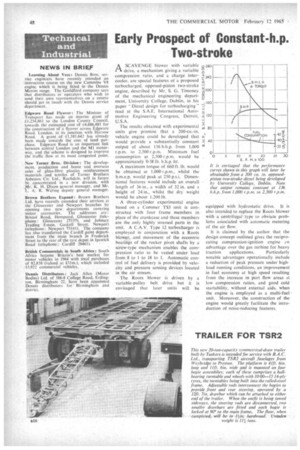Early Prospect of Constant-h.p.
Page 50

If you've noticed an error in this article please click here to report it so we can fix it.
Two-stroke
PAA SCAVENGE blower with variable drive, a mechanism giving a variable compression ratio, and a charge intercooler, are special features of a proposed turbocharged, opposed-piston two-stroke engine, described by Mr. S. 0. Timoney of the mechanical engineering department. University College, Dublin, in his paper "Diesel design for turbocharging " read at the S.A.E. International Automotive Engineering Congress. Detroit, U.S.A.
The results obtained with experimental units give promise that a 200-cu.-in, vehicle engine could be developed that would provide a substantially constant output of about 136 b.h.p. from 1,000 r.p.m. to 2,500 r.p.m. Minimum fuel consumption at 2,500 r.p.m. would be approximately 0-38 lb. b.h.p. hr.
A maximum torque of 660 ft. lb. wouldbe obtained at 1,000 r.p.m., whilst the b.m.e.p. would peak at 250 p.s.i. Dimensional features would include an overall length of 36 in., a width of 32 in. and a height of 24 in., whilst the dry weight would be about 1,200 lb.
A three-cylinder experimental engine based on a Commer TS3 unit is constructed with four frame members in place of the crankcase and these members are the only highly stressed parts in the unit. A C.A.V, Type 12 turbocharger is employed in conjunction with a Roots blower, and movement of the eccentric bearings of the rocker pivot shafts by a screw-type mechanism enables the compression ratio to be varied under load from 8 to 1 to 18 to 1. Automatic control of fuel delivery is provided by velocity and pressure sensing devices located in the air stream.
The Roots blower is driven by a variable-pulley belt drive but it is envisaged that later units will be
equipped with hydrostatic drive. It is also intended to replace the Roots blower with a centrifugal type to obviate problems associated with automatic metering of the air flow.
It is claimed by the author that the design concept outlined gives the reciprocating compression-ignition engine an advantage over the gas turbine for heavy traction applications. Particularly notable advantages operationally include a reduction of peak pressure under highload running conditions, an improvement in fuel economy at high speed resulting from the increase in port flow areas At low compression ratios, and good cold startability, without external aids, when the engine is employed as a multi-fuel unit. Moreover, the construction of the engine would greatly facilitate the introduction of noise-reducing features.






























































































































